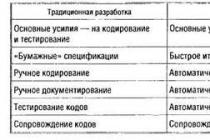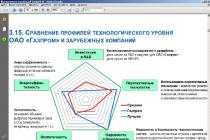If the trajectory of the point is known, then the dependence of the path traveled by the point on the elapsed time interval gives a complete description of this movement. We have seen that for uniform motion such a dependence can be given in the form of formula (9.2). Relationship between and for individual moments time can also be set in the form of a table containing the corresponding values of the time interval and the distance traveled. Let us be given that the speed of some uniform motion is 2 m/s. Formula (9.2) in this case has the form . Let's make a table of the path and time of such a movement:
It is often convenient to depict the dependence of one quantity on another not by formulas or tables, but by graphs, which more clearly show the picture of changes in variable quantities and can facilitate calculations. Let's build a graph of the distance traveled versus time for the movement under consideration. To do this, take two mutually perpendicular lines - the coordinate axes; one of them (the abscissa axis) is called the time axis, and the other (the ordinate axis) is the path axis. Let's choose the scales for depicting time intervals and paths and take the point of intersection of the axes as the initial moment and as the starting point on the trajectory. Let's put on the axes the values of time and the distance traveled for the considered movement (Fig. 18). To “bind” the values of the distance traveled to time points, we draw perpendiculars to the axes from the corresponding points on the axes (for example, points 3 s and 6 m). The point of intersection of the perpendiculars corresponds simultaneously to both quantities: the path and the moment, - in this way the "binding" is achieved. The same construction can be performed for any other time points and corresponding paths, obtaining for each such pair of time - path values one point on the graph. On fig. 18, such a construction is performed, replacing both rows of the table with one row of dots. If such a construction were performed for all moments of time, then instead of individual points, a solid line would be obtained (also shown in the figure). This line is called the path versus time graph, or, in short, the path graph.

Rice. 18. Graph of the path of uniform movement at a speed of 2 m / s

Rice. 19. To exercise 12.1
In our case, the path graph turned out to be a straight line. It can be shown that the graph of the path of uniform motion is always a straight line; and vice versa: if the path versus time graph is a straight line, then the motion is uniform.
Repeating the construction for a different speed of movement, we find that the points of the graph for a higher speed lie higher than the corresponding points of the graph for a lower speed (Fig. 20). Thus, the greater the speed of uniform movement, the steeper the straight-line graph of the path, i.e., the greater the angle it makes with the time axis.

Rice. 20. Graphs of the path of uniform movements with speeds of 2 and 3 m/s

Rice. 21. Graph of the same movement as in fig. 18, drawn to a different scale
The slope of the graph depends, of course, not only on the numerical value of the speed, but also on the choice of time and length scales. For example, the graph shown in Fig. 21 gives the path versus time for the same movement as the graph in Fig. 18, although it has a different slope. From this it is clear that it is possible to compare movements by the slope of the graphs only if they are drawn on the same scale.
With the help of path graphs, you can easily solve various problems about movement. For an example in fig. 18 dashed lines show the constructions necessary to solve the following problems for a given movement: a) find the path traveled in 3.5 s; b) find the time for which the path of 9 m was covered. In the figure, the answers are found graphically (dashed lines): a) 7 m; b) 4.5 s.
On graphs that describe uniform rectilinear motion, you can plot the coordinate of the moving point along the y-axis instead of the path. Such a description opens up great possibilities. In particular, it makes it possible to distinguish the direction of motion with respect to the axis. In addition, taking the origin of time as zero, one can show the movement of a point at earlier times, which should be considered negative.

Rice. 22. Graphs of movements with the same speed, but with different initial positions of the moving point

Rice. 23. Graphs of several movements with negative velocities
For example, in fig. 22, straight line I is a graph of motion occurring at a positive speed of 4 m / s (i.e., in the direction of the axis ), and at the initial moment the moving point was at a point with coordinate m. For comparison, the same figure shows a graph of motion that occurs with the same speed, but at which at the initial moment the moving point is at the point with the coordinate (line II). Straight. III corresponds to the case when at the moment the moving point was at the point with the coordinate m. Finally, the straight line IV describes the motion in the case when the moving point had the coordinate at the moment c.
We see that the slopes of all four graphs are the same: the slope depends only on the speed of the moving point, and not on its initial position. When changing the initial position, the entire graph is simply transferred parallel to itself along the axis up or down by the appropriate distance.
Graphs of movements occurring at negative velocities (i.e., in the direction opposite to the direction of the axis ) are shown in fig. 23. They are straight, inclined downwards. For such movements, the coordinate of a point decreases with time., had coordinates
Path graphs can also be built for cases in which the body moves uniformly for a certain period of time, then moves uniformly, but at a different speed for a different period of time, then changes speed again, etc. For example, in fig. 26 shows a motion graph in which the body moved during the first hour at a speed of 20 km/h, during the second hour at a speed of 40 km/h, and during the third hour at a speed of 15 km/h.
Exercise: 12.8. Build a path graph for movement in which the body had speeds of 10, -5, 0, 2, -7 km/h for successive hourly intervals. What is the total displacement of the body?
Let's get acquainted in more detail with the most visual way of describing the movement - graphic - on the example of a uniform rectilinear movement.
Graph of the speed module
With uniform rectilinear motion, the speed v x \u003d const. Consequently, its modulus v = const, i.e. does not change over time. The graph of the dependence of the speed module on time 1 is the straight line AB, parallel to the time axis and located above this axis, since v> O (Fig. 1.9).
Rice. 1.9
The area of the OABS rectangle shaded in the figure is numerically equal to the path traveled by the body in time t. After all, the OA side on a certain scale is the speed modulus v, and the OS side is the time of movement t, therefore s = vt.
Speed Graph
In contrast to the speed modulus, the speed determined by expression (1.4.1) can be positive or negative. Therefore, the graph of the dependence of the speed v x on time t can be either the straight line BC or the straight line KF (Fig. 1.10).

Rice. 1.10
Both lines are parallel to the time axis. The straight line BC corresponds to a positive value of the speed (v 1x > 0), and the straight line KF corresponds to a negative value (v 2x< 0).
The areas of the rectangles OBCD and OEFK shaded in the figure are numerically equal to the corresponding changes in the coordinates of moving bodies during their movement. Since v 1x > O, then the change in the coordinates of the first body Аx 1 = v 1x t 1 is positive. Therefore, the area of the rectangle OBCD is assigned a positive sign. The speed of movement of the second body is negative: v 2x< 0. Поэтому отрицательным будет и изменение координаты Ах 2 = v 2x t 2 . В этом случае изменение координаты численно равно площади лежащего ниже оси времени прямоугольника OEFK, взятой со знаком «минус».
Path chart
With uniform rectilinear motion, the path is directly proportional to time, since the modulus of speed is v \u003d const: s \u003d vt. Therefore, the graph expressing the dependence of the path on time is a straight line coming out of the origin (s(0) = 0). Remember that the path is not negative and cannot decrease in the process of movement. The greater the speed modulus, the greater the angle the graph forms with the time axis.
Figure 1.11 shows path graphs 1 and 2 for two moving bodies. Since the first body traveled a distance of 1 m in 2 s, the velocity modulus of the first body is equal to v 1 = 0.5 m/s.

Rice. 1.11
The speed modulus of the second body is equal to v 2 = 2 m / s, since in 1 s the body traveled a distance of 2 m.
In order to determine the path traveled by the body over a certain period of time from the graph of the path versus time, it is necessary from the point on the time axis corresponding to the end of the interval to restore the perpendicular to the intersection with the graph, and then from this point to lower the perpendicular to the s axis. The point of intersection of it with this axis will be the value of the path in this moment time.
Plot coordinate
Since the coordinate for uniform rectilinear motion is linear function time x \u003d x 0 + v x t, then the graph of the coordinate versus time is a straight line.
Figure 1.12 shows the graphs of coordinates versus time for three cases. Line 1 corresponds to the case of motion at x 01 = 0, v 1x > 0; straight line 2 - the case when x 02< 0, v 2x >0; and straight line 3 - to the case when x 03 > 0, v 3x< 0. Скорость v 2x больше, чем v 1x .

Rice. 1.12
Let's see what information can be extracted from the AB graph of the uniform motion of the body (Fig. 1.13).

Rice. 1.13
At the initial time (t 0 \u003d 0), the body had a coordinate x 0 \u003d 3 m, at time t 1 \u003d 6 c the body coordinate x 1 \u003d 0, i.e. it was at the origin, and at time t 2 = 9 s the body was on the X axis at a point with coordinate x 2 = -1.5 m. All this time the body was moving opposite to the positive direction of the X axis.
The speed of the body is v x = ![]() \u003d -0.5 m / s, and the modulus of speed v \u003d 0.5 m / s.
\u003d -0.5 m / s, and the modulus of speed v \u003d 0.5 m / s.
Pay attention to the fact that according to the x(t) dependence graph, one can judge the “past” in the movement of the body, i.e., one can find the position of the body before the start of the time reference, provided that even up to this moment the body has moved uniformly and rectilinearly with that the same speed. Time points before the start of counting are considered negative. According to Figure 1.13, 3 s before the start of the time reference, the body had a coordinate of 4.5 m.
1 In the following, for brevity, we will often say: "plot of the module of speed", "plot of the projection of velocity", etc.

 eat tasks:
eat tasks:

 hell 1.
hell 1.
 hell 3.
hell 3.
 moving straight and evenly, the car traveled 240 km in 3 hours. Plot a path versus time graph. Calculate the speed of the car and plot the speed versus time graph.
moving straight and evenly, the car traveled 240 km in 3 hours. Plot a path versus time graph. Calculate the speed of the car and plot the speed versus time graph. ) the speed of the first body is 2.5 times less than the speed of the second body;
) the speed of the first body is 2.5 times less than the speed of the second body; Task 8.
Task 8.
 Figure 7 shows the graphs of the path of three bodies versus time. How did these bodies move? Determine the speed of movement of each body, build graphs of the speed of υ 1, υ 2, υ 3 bodies versus time.
Figure 7 shows the graphs of the path of three bodies versus time. How did these bodies move? Determine the speed of movement of each body, build graphs of the speed of υ 1, υ 2, υ 3 bodies versus time. Task 10.
Task 10.

 Task 12.
Task 12.



 ,
, 

















